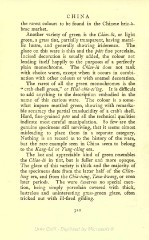Page 396 - Oriental Series Japan and China, Brinkly
P. 396
CHINA
the rarest colours to be found in the Chinese bric-a-
brac market.
Another variety of green is the Chiao-lu, or light
green, a grass tint, partially transparent, having metal-
lic lustre, and generally showing iridesence. The
glaze on this ware is thin and the pate fine porcelain.
Incised decoration is usually added, the colour not
lending itself happily to the purposes of a perfectly
plain monochrome. The Chiao-lu does not rank
with choice wares, except when it occurs in combi-
nation with other colours or with enamel decoration.
The rarest of all the green monochromes is the
" crab-shell green," or Hiai-chia-ts'ing. It is difficult
to add anything to the description embodied in the
name of this curious ware. The colour is a some-
what impure mottled green, showing with remarka-
ble accuracy the partial translucidity of a crab's shell.
Hard, fine-grained pate and all the technical qualities
indicate most careful manipulation. So few are the
genuine specimens still surviving, that it seems almost
misleading to place them in a separate category.
Nothing is on record as to the history of the ware,
but the rare example seen in China seem to belong
to the Kang-hsi or Tung-ching era.
The last and appreciable kind of green resembles
the Chiao-lu in tint, but is fuller and more opaque.
The glaze of this variety is thick and the majority of
the specimens date from the latter half of the Chien-
lung era, and from the Chia-tsing, Taou-kwang, or even
later periods. The ware deserves no special men-
tion, being simply porcelain covered with thick,
lustreless and uninteresting grass-green glaze, often
tricked out with ill-fired gilding.
322

